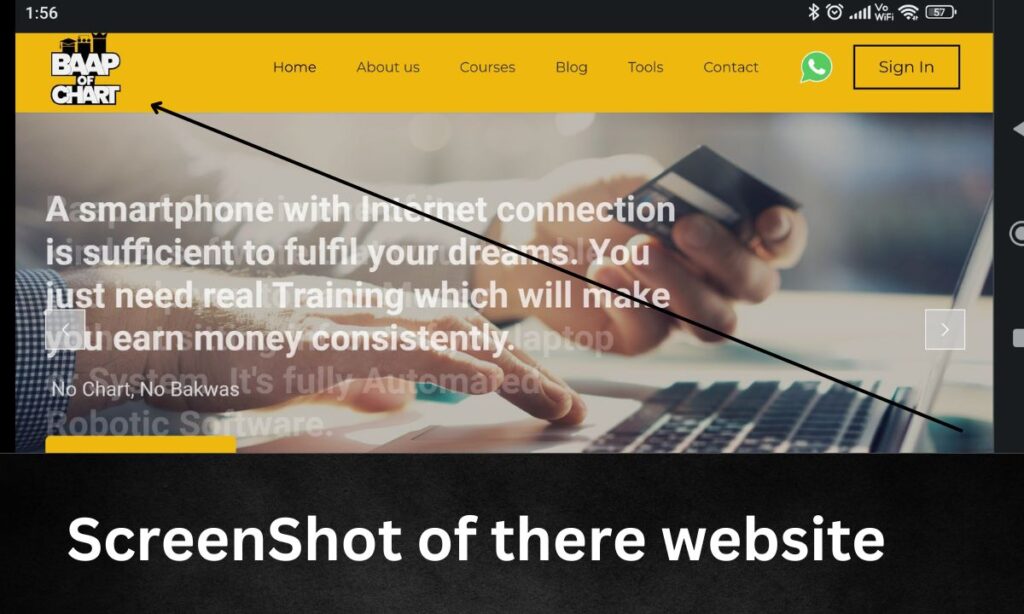In an era where financial influencers often vie online for your attention, the saga of the ‘Baap of Chart‘ provides a harsh reality check. As every aspiring trader marvelled at the compelling financial wizardry of Nasir Ansari, little did they know they were falling prey to the whims of one of the most infamous ‘finfluencers.’
More commonly known as the ‘Baap of Chart,’ Ansari was unravelled as an illusionist of numbers, a mastermind behind a massive deceptive plan that rocked the digital finance world. However, as the truth unfolded, Ansari’s so-called ’empire’ began to crumble, taking down with it the faith many of his followers had placed in him.
A Master Mind’s Masterplan: Nasir Ansari and His Web of Deceit
Nasir Ansari deftly maintained the grandiose façade of a savvy and successful stock trader. He guaranteed extraordinary returns on investment, promising 200% to 300% —the bait that lured thousands into his snare.
Under the Hood: A Portrayal versus Reality
What seemed too good to be true was indeed far from the truth as per the Securities and Exchange Board of India’s (SEBI) investigation. A deep dive into Ansari’s two trading accounts with Zerodha and Angel One exposed the stark reality—a net loss of ₹2,89,60,828.02 was unveiled.
The vast chasm between the promised returns and the actual outcomes triggers a loud alarm for followers of financial influencers to take their advice with a healthy dollop of scepticism.

Crafting Credibility: Strategies, Sessions, and Self-Proclaimed Claims
Ansari built credibility in his followers’ eyes by unveiling trading strategies, namely the “Shaktiman Strategy” and “360 Degree Strategy,” which, as per him, were bulletproof.
Furthermore, followers got a live glimpse into his supposedly successful trades during Zoom sessions where he shared real-time buy and sell tips. On Twitter, a claim of managing a fund worth ₹30 crore was flaunted, further solidifying his expertise.
However, none of these claims were legitimate. Under SEBI regulations, Ansari was neither licensed to give trading advice nor manage others’ funds, which pegs him as a law offender.
Unmasking the Fraud: SEBI’s Intervention
SEBI’s 45-page long order was a revealing chronicle of Ansari’s fraudulent operations. Instead of trading profits, as his ardent followers believed, Ansari raked in a colossal ₹17,20,76,616.09 by selling his misleading courses.
Post the exposures, SEBI has anchored swift actions against Ansari. It demanded that all his illicit earnings be parked in an escrow account, specifically a sum of ₹17 crores. Additionally, Ansari was banned from indulging in any trading activities in the stock market.

Impact and Aftermath
The money collected from Ansari’s falsehood will be returned to its rightful owners—innocent course subscribers duped by his sham guarantees.
The Dark Shadows of ‘Finfluencers’: A Wake-Up Call
The unravelling of the ‘Baap of Chart’ scandal sheds light on the dangerous underbelly of financial influencers’ space. It highlights the importance of verifying the credentials of these ‘finfluencers,’ and whether they possess the required legitimacy to offer financial advice.
The Need for Stricter Regulations and Financial Literacy
The incident highlights the urgent need for stringent regulations and vetting of financial influencers. Alongside regulations, financial literacy among the general public serves as another key safeguard against such predatory scams. Armed with informed knowledge, people can independently evaluate the veracity of financial advice, reducing their susceptibility to fraudsters.
Watch This Video For Better Understanding
Credits: A Digital Blogger (great explanation)
Conclusion
The ‘Baap of Chart’s’ fall reminds us to also be cautious of potential pitfalls and misleading counsel from non-credible influencers while savouring the convenience the digital age offers.
The episode underscores SEBI’s integral role, the importance of financial literacy, and the imperative need for due diligence when handling one’s hard-earned money. Remember—earning substantial wealth isn’t as easy or quick as it sometimes appears online.
Frequently Asked Questions (FAQs)
Who is Nasir Ansari, aka the ‘Baap of Chart’?
Nasir Ansari was a self-proclaimed financial influencer who gained widespread popularity for his stock trading expertise. He built trust in his followers by promising high returns on investment and sharing real-time buy and sell tips.
What was the main issue with the ‘Baap of Chart’ facade?
Nasir Ansari falsely portrayed himself as a successful stock trader, promising extraordinary profits. In reality, he was neither a registered investment advisor nor a research analyst with SEBI, operating illegally and providing false information to his followers.
Why is the ‘Baap of Chart’ an important case for SEBI?
The ‘Baap of Chart’ case highlights the rampant spread of financial scams online, and the critical role regulatory bodies such as SEBI play in safeguarding investors and maintaining the market’s integrity.
What were the deceptive strategies used by Nasir Ansari?
Ansari used manipulative ploys like promoting the “Shaktiman Strategy” and “360 Degree Strategy” under the pretence of being backtested, supposedly guaranteeing high profits. He also conducted live trading sessions over Zoom and claimed he managed a ₹30 crore fund on his Twitter account, all without required registrations as an investment advisor or research analyst.
How did SEBI unveil the ‘Baap of Chart’ lies, and what measures did they take?
SEBI conducted a thorough investigation uncovering the net loss in Ansari’s trading accounts and revealing his misleading promises on his trading strategies and courses. Ansari was ordered to deposit ₹17 crores (his ill-gotten earnings) into an escrow account and banned from trading activities until further notice.
What is the impact of this scandal on Ansari’s followers?
The followers who subscribed to Nasir Ansari’s deceptive courses will eventually get their money back, as the ₹17 crores collected will be refunded to them.
How have the actions of ‘finfluencers’ like the ‘Baap of Chart’ affected online financial advice credibility?
This scandal has raised questions on the legitimacy of financial influencers, emphasizing the need for stricter regulations and more awareness on investors’ part.
What regulatory measures can help prevent similar cases in the future?
Stricter regulations must be in place, ensuring that financial influencers hold the appropriate credentials before providing advice. SEBI and other regulatory bodies need to be more proactive, in monitoring and investigating suspicious activities and individuals.
How can financial literacy help protect people from scams like these?
Financial literacy arms individuals with the knowledge necessary to evaluate the quality of financial advice they receive, enabling them to distinguish between genuine recommendations and fraudulent schemes.
Read More :
- Shree Cement Q2 PAT Growth
- Ups and Downs of Reliance Industries
- Vedanta Ltd. Shares Amid Business Demerger Reports
- Strides Pharma Share Price Target
- Utkarsh Small Finance Bank’s Triumph
- HCC Share Price Target
- Karur Vysya Bank Stock
- Paytm Defies All Odds
- Bribes-for-Jobs Scandal Rocks TCS
- Updater Services Debut on the Stock Market

Nice blog here Also your site loads up fast What host are you using Can I get your affiliate link to your host I wish my web site loaded up as quickly as yours lol